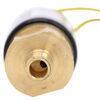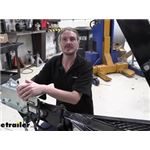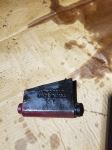Reverse Lockout Solenoid Kit for Demco DA66B Hydraulic Brake Actuators - Non-Bypass

- All Info
- Reviews (15)
- Q & A (0)
- Videos (2)
- Photos
Demco Accessories and Parts - DM5836
- Brake Actuator
- Disc Brakes
- Hydraulic Drum Brakes
- Solenoid
- Demco
Replaces or adds an inline reverse lockout solenoid to Demco DA66B hydraulic trailer brake actuator. Non-bypass design allows you to thread the solenoid valve into your master cylinder for a hassle-free installation.
Features:
- Solenoid kit allows you to replace or add a reverse lockout solenoid to your Demco hydraulic trailer brake actuator
- Allows you to move in reverse without engaging the trailer brakes
- Made in the USA
- Fits Demco model DA66B hydraulic trailer brake actuators
- Non-bypass configuration
- Allows you to install the solenoid without drilling into your master cylinder
- Easier to install than bypass models
- Made in the USA
- Includes both the solenoid cover and inline solenoid valve
- Made in the USA
5836 Demco Reverse Lockout In-Line Solenoid Kit with Cover for DA66B Hydraulic Brake Actuators - Non-Bypass


Videos are provided as a guide only. Refer to manufacturer installation instructions and specs for complete information.
Video Transcript for Demco Hydraulic Brake Actuator Reverse Lockout Solenoid Kit Installation
Hi there, surge break owners. Today we're gonna be taking a look at and showing you how to upgrade your existing surge break coupler to one with an electric lockout. This kit is specifically designed for Demco actuators and we've got a Demco easy connect actuator with drum brake unit in here, but this kit will also work with deep disc brake versions. We're just gonna take a look at it today and show you how to disassemble it to just do for your typical maintenance. If your master cylinder, something happens to wear out over time, gets filled up with the wrong type of fluid, a lot of moisture gets in there, anything like that and you gotta replace it, we're gonna show you how to be able to service it yourself here. So the first thing you would want to do is get the fluid out of the system.
So I actually took the bleeder screw at the back loose, but you could also take it loose right here at the back of the actuator. It was just easier to drain it into a container towards the rear, a little bit closer to the ground 'cause you really don't wanna get brake fluid on any painted surface. It is quite corrosive to paints and stuff. Your paint will come off of there, it'll discolor 'em, so just try to avoid that. We did place a napkin under here for when we take that loose for any of the fluid that's left in there.
When you do drain it, I do recommend that you pop the cap off here. That'll let it drain a little bit faster. Air can get in this way and let it drain out. So we've already let ours drain so we should be pretty dry at this point. So we're gonna head over to this side and we're gonna get our hoses disconnected here and our wiring disconnected.
Then we'll have to take out the bolts here that actually hold the entire coupler onto the trailer because the actuator inside's not just gonna slide out of there. We'll go ahead and begin our installation right here at the back of our actuator. When you're ready to add the lockout solenoid, you'll need to remove the connection right here at the back of the master cylinder or brake actuator. Now I've already gone ahead and drained the fluid from the system. I just opened one of the bleeder screws at the back.
If you open up the cap on top, the fluid will drain out a lot faster. You wanna fully pull it off there to make it drain faster. After it's done draining, I just usually thread it back on there 'cause if there is any little bit of fluid left from there, that does help to keep it from kind of dribbling out slower than it would if the cap was off. So we're gonna go ahead and remove this piece here. So we're gonna disconnect our line first. So we're gonna hold this piece while we disconnect the line. The piece to the back of our actuator, typically it's a half inch in size but it does vary slightly from manufacturer to manufacturer. But for our Demco here, it is gonna be a half inch. And the actuator we're installing is specifically designed to work with the Demco actuators 'cause we actually get some components that will protect the actuator in addition to the actuator itself. So we also are using a line wrench whenever working with our line 'cause the metal there is going to be softer than the head of a bolt or anything is gonna be. So you can see you get additional surface area there. If you need line wrenches, you can get some here at etrailer and this is what a standard box end wrench would look like, so make sure you are using the appropriate one. Once you get it loose enough, you can usually pull that off. Now again, we've already drained the fluid out so you can see there might be a little dribble there. You do want to prevent getting fluid on there, so if you've got a napkin you want to set down there, we've drained it so much already that we're good to go. But you may want to put a napkin down first 'cause brake fluid can be pretty corrosive to your paint and cause that to bubble and flake off there and stuff. So I wanna get that out of the way. Now the fitting that's here at the back of our actuator, we actually wanna remove this fitting. So we're gonna pull that fitting off of there. We're not gonna be using that fitting anymore because our new solenoid here that we're gonna install is gonna thread directly into it. We are gonna put a little bit of Loctite on it before we install it there to help seal it up and ensure it stays in place. This will thread into the back of our actuator. You do want to be careful and make sure that you're threading it in without cross threading it. So just make sure we're going straight in there. There we go. All right, that's about as tight as I can get it by hand there. You can see there's still a gap. We're not all the way tight yet. Now there are flat spots on each side that will accept a 7/8 wrench. So you can use those to finish snugging it down. Now again, it is threading into a plastic actuator or brake master cylinder, whichever you wanna call that, but it is all a plastic assembly. So you do want to be careful and make sure you're not over tightening it. And actually with this particular trailer, you might notice that once you get so far, it can be difficult to get your wrench on it 'cause it's hitting the bottom of the trailer there. So what I found works fairly well if you do run into that is that you can use the nut here on this side but you don't want to use just this nut. This is gonna be a 9/16 in size, but I'm also going to be using a set of Channellocks over here. I'm just gonna be using both. The Channellocks will do the majority of the work but to help prevent my Channellocks from slipping and giving myself a little bit extra edge, we can use this as well but we don't want to just use this to tighten it cause you can actually over tighten the mechanism that's inside. And we really only need to turn it far enough to be able to get our wrench back on it again. So just a little bit of a turn like that. And once our wrench will slide back on there again, we'll finish snugging it down. And I'm not going too crazy tight 'cause again it is just a plastic housing with all the throw that I've got of this wrench on there. It doesn't really feel like it's all that tight, but I don't think I would feel comfortable going any tighter than what we are about there. If I had to guess about the amount of pressure that I'm putting on it, I'd say we're probably only putting on maybe 25-inch pounds. It's really not all that much. That should be probably pretty good right there. Take our line and reinstall it and start it by hand. Go as far as you can by hand first 'cause again we don't want to cross thread anything especially once you get this far. So we got that in there now. Now you need your wrench to hold this 'cause we don't want to damage the solenoid. So hold that and then use your 3/8 wrench to snug it down and of course your line wrench. And then what sometimes I'll do is with this being a flex hose, I'll turn the flex hose this direction, twist the flex hose beforehand so that way, when I go to snug it down, it twists the hose back up right. So we're gonna loosen it just a hair, twist our hose just a little bit. Snug it down by hand. And we will put our wrench on there and snug it down with our 3/8 wrench. There we go, and that's decently snug. We'll put maybe a little bit more on it and you'll notice that the line has a nice gentle curve in there. We're not twisting the hose. The pre-twists we did will allow it to bend back up right and go down. Hook up our lockout solenoid. They do come pre-stripped, but we probably wanna strip back just a little bit more. That'll be a difficult amount to be able to attach to. So one of course is gonna go to ground and we've got our ring terminal here that we can reinstall into the location there. And then the other one here, we're gonna clean this up and reattach it back into the trailer there. So we're gonna just go ahead and strip these back just a little bit more. Now they're both yellow because it doesn't matter which one goes where. Just one of them has to go to ground and the other one has to go to the reverse lockout circuit or that would be the reverse slide or backup circuit from your vehicle. Strip that one back and we'll strip this one back just a little bit more. All right. So we'll go ahead and hook up our ground first since it's right here. Strip that one back. Wanna take a heat shrink butt connector, slide it over the end there and crimp it down. And I do recommend a heat shrink butt connector because we're outside the vehicle. It's on a boat trailer. This is definitely gonna be exposed to moisture, so we'll seal up the ends with our heat gun once we've got our connections made. And based on length, I think I'm gonna use the one that's a little bit higher up on top for the ground one just to make sure I got enough length wire to reach down here to our other circuit. This one's just a little bit closer. And we'll get the electrical tape off here, get this one cleaned up, and we'll get our other one attached the same way back to the circuit. With our heat gun, we'll seal those up. We can now go ahead and reinstall our ground wire. We'll push that wire loom back on there. Line it back up with the hole, reinsert it, and then use our 15/16 or 8 millimeter to run it back down. Make sure it can't rotate. We got a good ground and now we can reinstall the cover onto the back here covering this stuff up. This does need to be done before you go to fill up the fluid because without these four fasteners tightened down it can pull in air around that gasket that we saw and we had it disassembled. So we'll just line that back up there, put our fasteners back down in there, make sure we start 'em by hand, and then go ahead and run 'em on down. And now we just wanna snug these back up 'cause we didn't have 'em all the way fully tightened. Now you don't want to tighten them very tight 'cause again it is just a plastic housing. It threads into a metal nut, but you don't want to compress it too far. So just stay on the lighter side. If you have an inch-pound torque wrench, you would probably want to use that and keep it fairly low. So this is a drum break set up here and you're gonna find your bleeder screw on the wheel cylinder where you hooked up your line. It should be right next to it. Now if you we're working on a disc brake set up, I've got a sample caliper here to show you. Should be something like this. And you'll notice on the disc brake set up, this is where the line would enter, and here's the bleeder screws. Now not all disc brake calipers are gonna have two bleeder screws, but if they do have two bleeder screws, you would always want to use the top bleeder screw when bleeding your brakes. And the size of the bleeder screw can vary. It looks like this is probably 5/16 for this Kodiak caliper. And over on our drum break here, I know that that's gonna be a 3/8 in size. So we're gonna be bleeding drum breaks. But again, the procedure's the same. it's just the location of the bleeder that you need to really pay attention to, and always use the top one. With drum breaks, you shouldn't have multiple. There should just be this one. And when I do this, I always wanna start at the wheel that is furthest from the actuator. So we're gonna go ahead and start on the passenger side rear here. That's typically the furthest one, but depends on where your actuator's located. If it's in the center, the left, or the right. So we're gonna start on this one though 'cause this is the typical, usually the furthest rear. For us it's gonna be the furthest to the rear. So now we're gonna go ahead and take our little cap off of there. Don't lose your cap. It's nice to have that on there to keep dirt and debris and stuff from filling up in here and clogging up your bleeder screw for future maintenance and things like that. So we're gonna go ahead and loosen this up. Now we haven't filled it with fluid yet, but we're gonna do gravity bleeding first to let nature and gravity do most of the work for us here. Minimize how much we have to pump our system. So I'm opening up the bleeder screw, and I went ahead and pulled it open just a couple of threads there. In most cases, you don't need to open it that far when bleeding, but when doing gravity bleeding, a little bit extra opening helps that flow just work naturally better. So you may also want to take a rubber hose and place that on there and bring it down to your pan because brake fluid can be pretty bad for painted surfaces, wearing off the paint and stuff. So we're gonna also grab a little hose and have that go down to our drain pan here just to minimize exposure brake fluid on our components. All right, we've slid our hose on there to direct it down into either a container or a pan. We do have a container that we just rigged up here. This is just an old sports drink bottle. So this works out fairly well for something like this. But again, we have a pan under here as well just in case the hose does drip a little bit, we're catching it. So now we're gonna head up to our actuator and we're gonna go ahead and fill it up and then let nature take its course and let gravity do the best it can to start pushing the air from the front back through our lines and out and getting that fluid there. Now even though we are gonna be gravity bleeding it, you are still gonna have to do some pumping. Gravity's not gonna do all the work, but it will minimize how much physical labor you have to do. So here we are at the front. Now I went and took the cap off of our actuator. If you look at the top here, you'll notice that it tells you what specification of fluid to use. You can use either DOT 3 or 4 fluid in this particular setup. We're gonna be using DOT 3 today. Again, you can use either. You do wanna make sure that you're using brake fluid from a new container 'cause brake fluid is hydroscopic which means it absorbs moisture. So even an open container that's been sitting for a while can actually draw that moisture out of the air. And the more moisture that is in your brake fluid, the lower the boiling point is in the fluid and we don't want fluid to boil. We're gonna be careful not to spill the fluid, and go ahead and fill it up. And since we're gonna be bleeding it, we're gonna get it pretty close to the top 'cause we are gonna be losing fluid as it goes through the system and out towards the container that we have at the back. All right, so we've got it filled up there. We're gonna go ahead and let gravity take its course. So you're probably gonna see some bubbles there as it starts to make its way through the system. Some of the air's gonna come to the top here. Some of the air's gonna get pushed back through that open bleeder screw we have towards the rear. We went and let gravity bleed for a while. We ended up not really getting any fluid out the back. Sometimes you do, sometimes you don't. Sometimes lifting up the front of the trailer to make it the highest point which it should already be the highest but sometimes lifting it up a little higher can help speed up that process or get it started. But in the event that it doesn't, no big deal. You can still pump it manually. So we've got it all topped up here. After you've got it topped up, it is a good idea to put the cap on. In a lot of cases, you don't want the cap on when bleeding but we're trying to minimize how much mess we make here. So keep it from squirting back out of there. Our assistant is gonna push in and we're gonna be at the back and we're gonna open up the bleeder screw. So we're gonna go ahead and head to the back now to the wheel and we'll communicate with our assistant here to press. And what we want to happen is we want our assistant to press it in. We'll open the bleeder screw, let the fluid come out or air whatever we get out of it. We'll close it. Our assistant will then release, and then he will then press in and we'll just repeat that process over and over. But we never want to have the bleeder screw in the back open when our assistant is releasing 'cause that's gonna draw air back in our bleeder screw. Go ahead and push it in. Our assistant's gonna press. We're gonna open and there's our fluid coming out. I can see a few air bubbles there. So we're gonna go ahead and close it back up. Okay, you can go ahead and release. Our assistant's now released. So then what we're gonna do is we're gonna now have him press it again and we're gonna open it again and just keep rinsing and repeat until we get a solid stream of fluid out. Every few presses, you may wanna recheck your reservoir and refill the fluid 'cause you don't want it to go empty. If it goes empty up there, it's now drawing in air from the front and we don't want any air in our system. So go ahead and press. There you can see all that air shooting out of there, so we're gonna close it. You can go ahead and release. And now it's released. You can go ahead and press again. And that was a pretty good solid stream we've got there. So we're gonna double check our reservoir, probably hit this one one or two more times, then we're gonna head over to the other side and do that one and you just rinse and repeat for however many wheels that you have until you get a solid stream out of each one. Once you've got everything bled, you can go ahead and reinstall your wheels. If you purchased new drums and hubs from us, they do come with new lug nuts for half-inch studs so you can utilize those as well. We can go ahead now and tighten them down. The new nuts that it comes with is gonna be a 21-millimeter in size. and when tightening 'em down, you wanna do it in a star pattern. This will ensure the wheel draws in evenly and the tapered side of the nuts should face the wheel with the flat side facing outward. And once you get this back on the ground, you'll wanna make sure you torque your lug nuts to the manufacturer's specifications. And that completes our look at Demco's lockout solenoid and plate upgrade kit..
Customer Satisfaction Score:
94% were satisfied with this product
6% of customers were not satisfied
- Wrong item was ordered
- etrailer mistake
- Alternate product found
Customer Reviews
Reverse Lockout Solenoid Kit for Demco DA66B Hydraulic Brake Actuators - Non-Bypass - DM5836
Average Customer Rating: 4.9 out of 5 stars (15 Customer Reviews)
Replaces or adds an inline reverse lockout solenoid to Demco DA66B hydraulic trailer brake actuator. Non-bypass design allows you to thread the solenoid valve into your master cylinder for a hassle-free installation.Overall I'm really pleased with this purchase. I installed it on a replacement Demco coupler with surge brake actuator. Unfortunately the new coupler doesn't have a manual brake lockout, so I was excited to find this product! (My driveway is uphill as I back my trailer in, so a lockout/bypass is necessary.) etrailer was unable to give me any measurements when I called to confirm it would fit, so I added photos to help the next customer. It would have been a 5 star rating, but the threads were cut too poorly to work with the existing hydraulic lines. Fortunately I had the right size die to cut them deeper. So far it seems to work great! I've purchased several items from etrailer and recommend them to friends!
I truly appreciate the professionalism and courtesy of the people, and the quality of their products.
Products are very good and everything works and went together well. Customer service was excellent!

Works as advertised. The cover is stout. I have stood on it several times. If you are going to redo a trailer yourself, this is the only website you need.
i purchased this unit along with the electric lock out solenoid. they were priced excellent and arived promtly. very high quality units and very easy to install. only wish a page on how to bleed the unit came with it, instead of having to hunt one up on the internet. after finding instructions on how to bleed th unit it was quite simple and easy.very satified with the purchase
Item was perfect and very fast shipment
See what our Experts say about this Demco Accessories and Parts
- Reverse Lockout To Use with Demco Surge Actuator for Drum Brakes # DM72VRWhile we don't offer a version of the Demco Actuator part DM72VR with a reverse lockout we do offer a lockout that will work great with it that you can order separately with it as part # DM5836.
view full answer... - How to Wire Reverse Lockout Solenoid Kit for Demco DA66B Hydraulic Brake ActuatorsThe wires on the Reverse Lockout Solenoid Kit # DM5836 are for the ground and the reverse light circuit. It does not matter which wire you use for the two connections, it will work either way. If you take a look at the installation video below starting at the 8 minute mark you can see exactly how this is done.
view full answer... - Recommended Reverse Lockout for a Demco Surge Actuator for Drum Brakes # DM72VRYes, the Reverse Lockout Solenoid Kit for Demco DA66B Hydraulic Brake Actuators item # DM5836 will work great with the Demco Hydraulic Brake Actuator item # DM72VR.
view full answer... - Availability of Demco Surge Actuator for Drum Brakes with Electric LockoutThe Demco actuator part # DM72VR does not come with a lock out and there isn't a version that does but you can easily add on one with the part # DM5836.
view full answer... - How To Add Reverse Lockout To Demco Hydraulic Trailer Brake Actuator 8605001To add reverse lockout to the Demco Hydraulic Trailer Brake Actuator - Drum Brakes - Zinc Plated - 2" Ball - 6,000 lbs 8605001 you purchased you will need the Reverse Lockout Solenoid Kit for Demco DA66B Hydraulic Brake Actuators - Non-Bypass # DM5836. One wire from the # DM5836 will get grounded, and the other will get attached to a 5-way connector on your trailer. If you do not have a 5-way connector on your trailer currently you will need to add one using # HM37918. Once the trailer...
view full answer... - Reverse Lockout Solenoid Kit for Demco Hydraulic Brake Actuator # DM72VRYou will need the Reverse Lockout Solenoid Kit # DM5836 for the Demco Hydraulic Brake Actuator # DM72VR. I have included a install video below showing the installation of the solenoid kit on this actuator. The Kit # DM5837 you found is for Demco models DA10 and DA91 hydraulic trailer brake actuators.
view full answer... - Reverse Lockout Solenoid Replacement for Demco with 800 psi RatingDo you happen to know what brand of actuator you have. I can't find any info on the part number you mentioned but if you can let me know what brand you have I can see what you'd need if we have a solution.
view full answer... - Troubleshooting Brakes Locking Up in Reverse on Yacht Club Boat TrailerIt sounds like you have a hydraulic brake actuator like the Demco Hydraulic Brake Actuator # DM72VR on your Yacht Club boat trailer. In order to keep the brakes from activating, you need to have a reverse lockout on your brake actuator. It is possible that your current brake actuator has a manual lockout, or is capable of manual lockout using a key like the # DX94FR. You will need to identify your current brake actuator in order to determine if it has a reverse lockout or not. If that...
view full answer... - Reverse Lockout Solenoid Kit For Demco Hydraulic Brake Actuator DM72VRYep, we do have a reverse lockout solenoid for the Demco Hydraulic Brake Actuator # DM72VR. There isn't a manual lockout option, so if you're okay with that, what you need is the following: - Reverse Lockout Solenoid Kit # DM5836
view full answer... - Drum Brake Surge Coupler With Reverse Lock Out To Replace TDE 7000 On 2007 Tahoe Boat TrailerYou will want to replace your TDE 7000 actuator with the Demco Hydraulic Brake Actuator # DM72VR. This will bolt to a 3" wide trailer pole tongue and is specific for drum brakes. The actuator has a zinc coating which is more resistant to corrosion than paint. And the upgraded EZ latch coupler makes connecting to the hitch ball easier and more reassuring since you can visibly tell when the latch drops into place. You can add the Reverse Lockout Solenoid Kit # DM5836 so you can still prevent...
view full answer... - Replacing Drum Brake Actuator on Boat Trailer With Swing Away Coupler TDE LP7000There is not going to be a direct replacement for your exact setup as Tie Down Engineering no longer manufacturers these. You will need to have the Actuator LP7000 cut out of your swing away front coupler. Then you will be able to weld in a section of 3" wide channel tongue which you will then be able to attach the Demco Hydraulic Brake Actuator # DM72VR. Finally you will then use the Reverse Lockout Solenoid Kit # DM5836 since you have the reverse lockout valve.
view full answer... - Installation of Reverse Lockout Solenoid Kit for Demco DA66B Actuator DM5836I reached out to Demco, who said they don't have an installation manual for the Reverse Lockout Solenoid Kit for Demco DA66B Hydraulic Brake Actuators - Non-Bypass # DM5836. They said the reason for that was it was just a few steps, though they did detail the process, as follows: "All that is required is to take out the two bolts in the back that hold the master cylinder in place, and mount the solenoid cover to that location using the same bolts. To place the inline solenoid on the...
view full answer... - Correct Lockout Kit for Demco Hydraulic Brake Actuator DA86Yes, the Reverse Lockout Solenoid Kit for Demco DA66B Hydraulic Brake Actuators part # DM5836 will work great with the Demco Hydraulic Brake Actuator part # DM72VR.
view full answer... - Can Reverse Lock Out Solenoid be Added to Demco Actuator DM72VRActually you can add an electric lockout to the Demco actuator part # DM72VR pretty easily with the part # DM5836 and you'd be set!
view full answer... - Reverse Lockout Solenoid for Demco DA86 ActuatorThe correct reverse lockout solenoid for the Demco DA86 actuator part # DM72VR is the part # DM5836.
view full answer... - Is There Manual Lockout Available for Demco Surge Actuator part # DM72VRDemco does not offer a manual lockout for the coupler part # DM72VR but they do offer an electric option with the part # DM5836. They also recommend installing free-backing brake assemblies on the axles instead too which I attached a link to a page that has all of them.
view full answer... - Solution For Pushing Trailer Without Brake Actuator Lockout With Front Hitch UphillYou are correct, pushing the trailer with the # DM72VR uphill will cause the brakes to activate so this will be a problem. Typically you could add an electric lockout using the # DM5836, but since you are pushing it forward you would need some custom wiring to get power since you are driving forward and a 5-way only works in reverse. Assuming you don't want to install custom wiring I have two possible solutions. The first is to get a different coupler. You could use the Brake Actuator...
view full answer... - Atwood 82453 Surge Brake Coupler Master Cylinder ReplacementThere is no longer a replacement for that particular master cylinder. Atwood is out of business and Demco did acquire the coupler part of their business, but have not made replacement parts for older couplers. The closest option we have to replace your Atwood 82543 actuator is part # DM72VR. However, it doesn't have the lockout like your Atwood does. To add a lockout and shield use # DM5836. It wires into the reverse light circuit on your trailer through the trailer connector. I realize...
view full answer... - Recommended Reverse Solenoid For Demco Hydraulic Brake Actuator # DM72VRThe Reverse Lockout Solenoid Kit # DM5836 is the correct kit needed for the Demco Hydraulic Brake Actuator # DM72VR. This kit will allow you to install the solenoid without drilling into your master cylinder. I linked an installation video below. If you have any further questions please feel free to reach back out to me anytime and I would be more than happy to further assist you.
view full answer... - Recommended Replacement Brake Actuator for a Tie Down Engineering 6,600 lb ActuatorHey Jim, for your Tie Down Engineering 6,600 lb actuator I recommend the Demco Hydraulic Brake Actuator # DM72VR with the reverse solenoid # DM5836. This actuator has a 7,000 lb capacity, works with 2" hitch balls and drum brakes, and will work with 3" trailer frames.
view full answer... - Replacement Drum Brake Surge Coupler for 2-Inch Surge Coupler with Electric LockoutTo replace your Dico surge actuator the Demco Hydraulic Trailer Brake Actuator # DM72VR would be a really great choice. It has a 6k capacity, fits a 2 inch ball, and with the reverse lock out solenoid kit part # DM5836 with it you'd be totally set.
view full answer... - Replacement Coupler/Actuator For a 2002 Mastercraft Maristar 210 Boat Trailer With Drum BrakesIt sounds like you may be wanting to replace just the coupler portion of the actuator. Typically the best option for a surge brake actuator with a bad coupler, is to replace the entire actuator. To replace just the coupler, I would need to know the exact make and model of your surge brake actuator, in order in to see if a replacement coupler is available, which is not always the case. I was only able to find minimal information on your trailer, but the Demco Hydraulic Brake Actuator #...
view full answer...
Do you have a question about this Accessories and Part?
Info for this part was:








At etrailer.com we provide the best information available about the products we sell. We take the quality of our information seriously so that you can get the right part the first time. Let us know if anything is missing or if you have any questions.













































































Thank you! Your comment has been submitted successfully. You should be able to view your question/comment here within a few days.
Error submitting comment. Please try again momentarily.